A Report on Ethical Issues and Sustainability in Uber Technologies
VerifiedAdded on 2021/04/21
|10
|1928
|73
Report
AI Summary
This report provides an in-depth analysis of the ethical issues faced by Uber Technologies Incorporation within the transportation industry. It examines the controversies surrounding Uber, including its impact on taxi drivers, competitors, and the public, and how these issues stem from its business practices. The report highlights key ethical concerns such as the reduction in taxi drivers' earnings, increased unemployment rates, and the misuse of market dominance. It discusses various alternatives for addressing these ethical issues, such as collaborating with local authorities to provide employment opportunities and setting minimum wage standards for drivers, and providing human backups for self-driving vehicles. The report recommends that Uber prioritize stakeholder interests in its decision-making processes and enhance its corporate social responsibility policies to ensure ethical conduct.

Running head: UBER 0
Ethics and Sustainability
Uber Technologies Incorporation
Ethics and Sustainability
Uber Technologies Incorporation
Paraphrase This Document
Need a fresh take? Get an instant paraphrase of this document with our AI Paraphraser
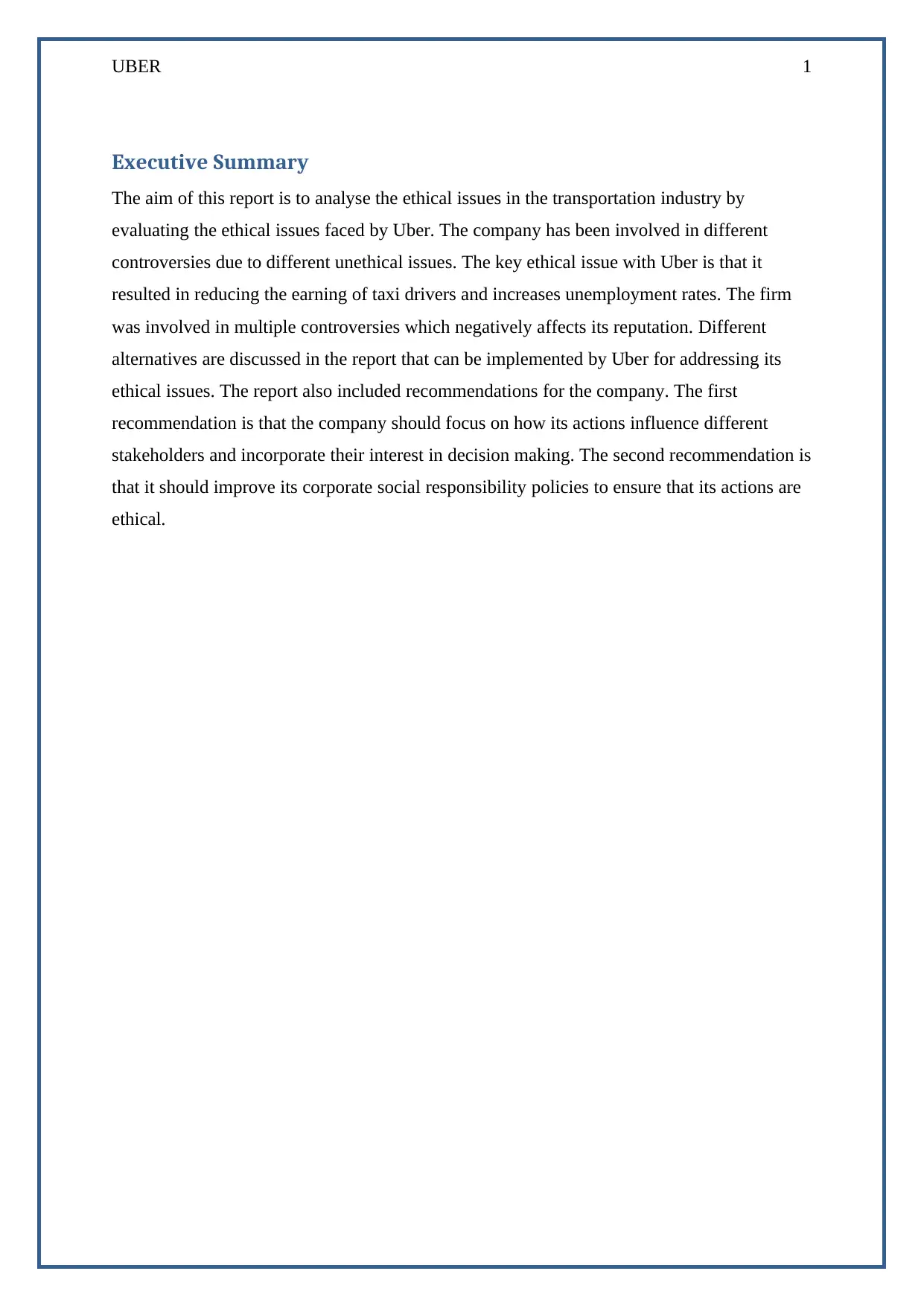
UBER 1
Executive Summary
The aim of this report is to analyse the ethical issues in the transportation industry by
evaluating the ethical issues faced by Uber. The company has been involved in different
controversies due to different unethical issues. The key ethical issue with Uber is that it
resulted in reducing the earning of taxi drivers and increases unemployment rates. The firm
was involved in multiple controversies which negatively affects its reputation. Different
alternatives are discussed in the report that can be implemented by Uber for addressing its
ethical issues. The report also included recommendations for the company. The first
recommendation is that the company should focus on how its actions influence different
stakeholders and incorporate their interest in decision making. The second recommendation is
that it should improve its corporate social responsibility policies to ensure that its actions are
ethical.
Executive Summary
The aim of this report is to analyse the ethical issues in the transportation industry by
evaluating the ethical issues faced by Uber. The company has been involved in different
controversies due to different unethical issues. The key ethical issue with Uber is that it
resulted in reducing the earning of taxi drivers and increases unemployment rates. The firm
was involved in multiple controversies which negatively affects its reputation. Different
alternatives are discussed in the report that can be implemented by Uber for addressing its
ethical issues. The report also included recommendations for the company. The first
recommendation is that the company should focus on how its actions influence different
stakeholders and incorporate their interest in decision making. The second recommendation is
that it should improve its corporate social responsibility policies to ensure that its actions are
ethical.
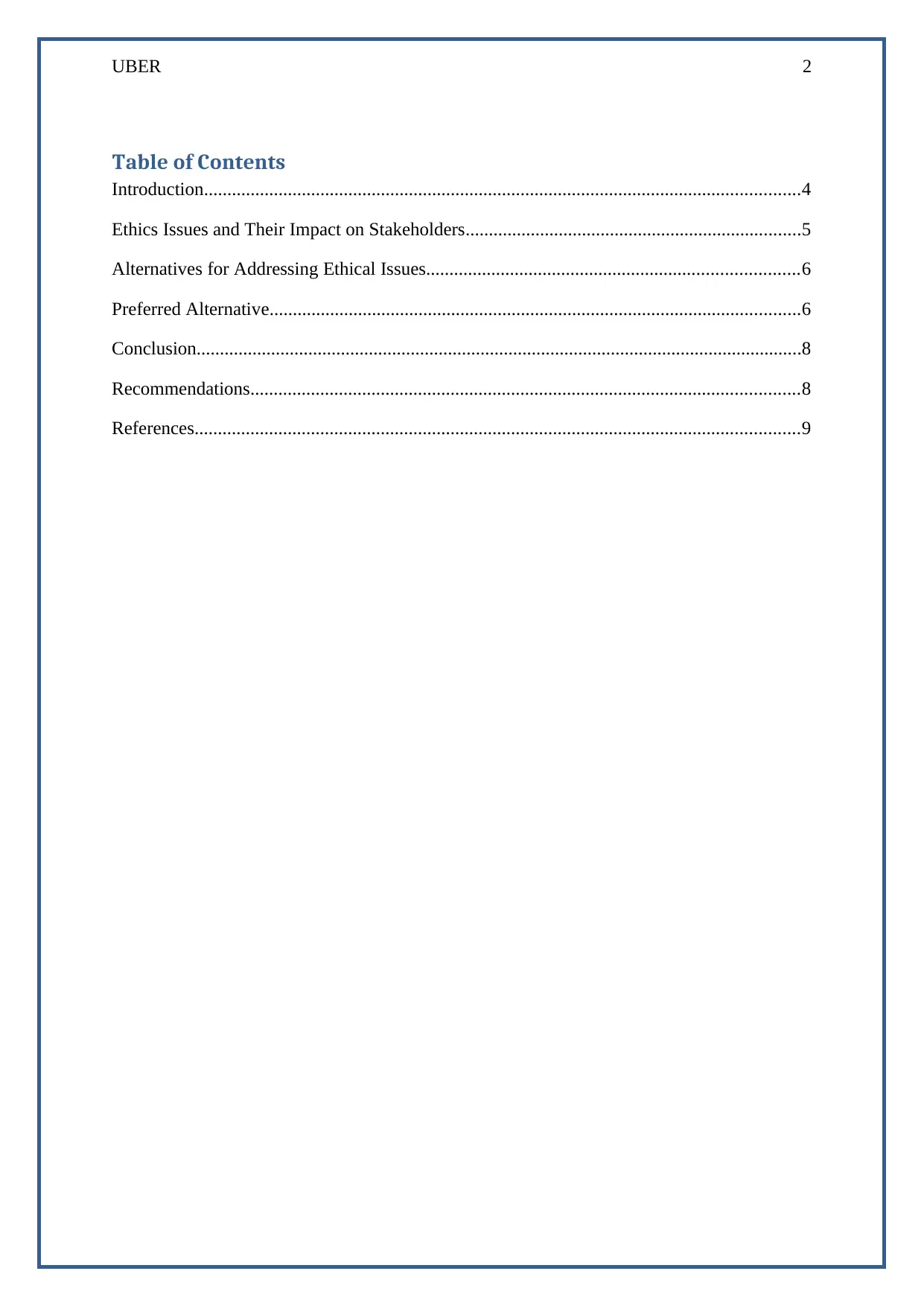
UBER 2
Table of Contents
Introduction................................................................................................................................4
Ethics Issues and Their Impact on Stakeholders........................................................................5
Alternatives for Addressing Ethical Issues................................................................................6
Preferred Alternative..................................................................................................................6
Conclusion..................................................................................................................................8
Recommendations......................................................................................................................8
References..................................................................................................................................9
Table of Contents
Introduction................................................................................................................................4
Ethics Issues and Their Impact on Stakeholders........................................................................5
Alternatives for Addressing Ethical Issues................................................................................6
Preferred Alternative..................................................................................................................6
Conclusion..................................................................................................................................8
Recommendations......................................................................................................................8
References..................................................................................................................................9
⊘ This is a preview!⊘
Do you want full access?
Subscribe today to unlock all pages.

Trusted by 1+ million students worldwide
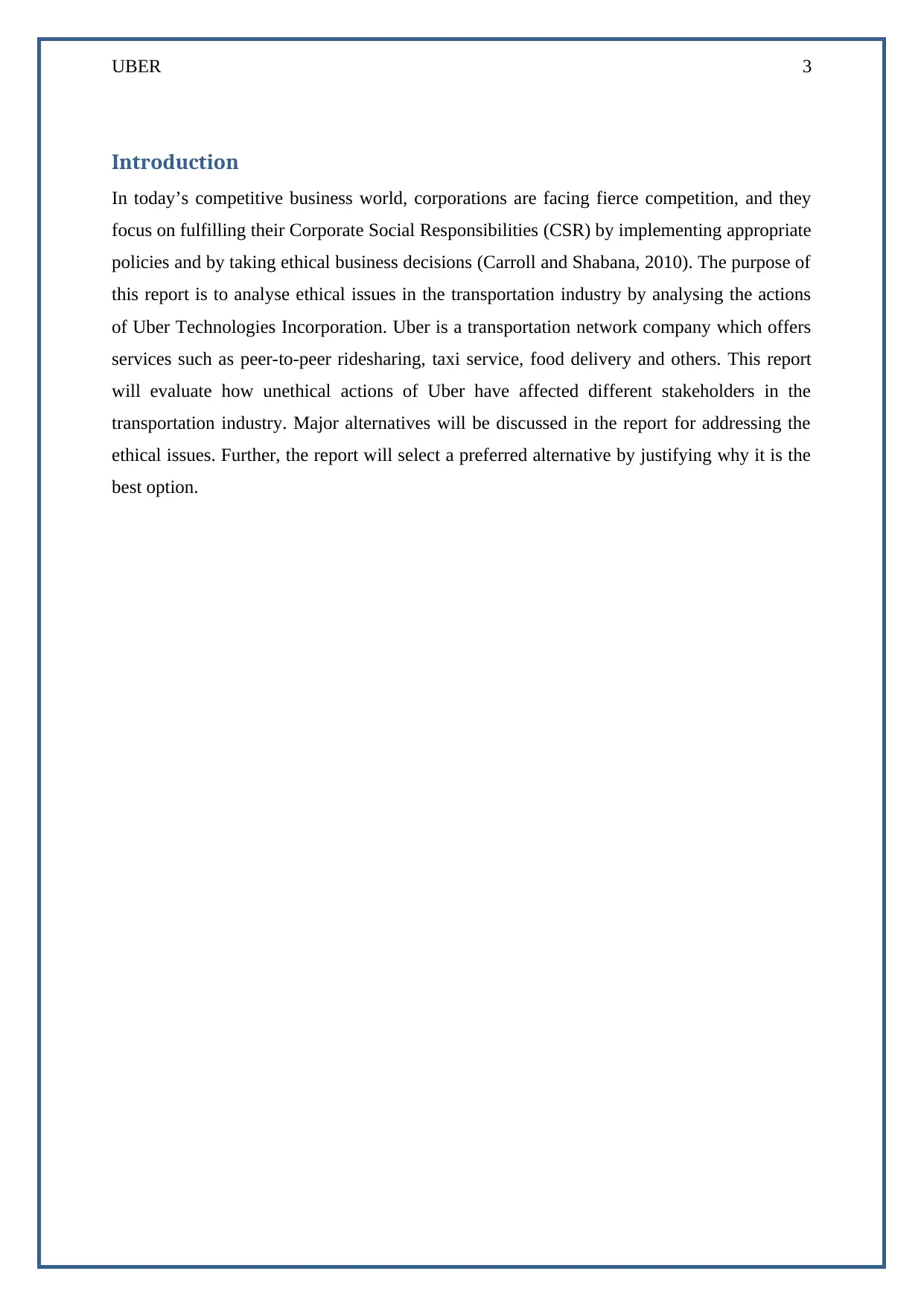
UBER 3
Introduction
In today’s competitive business world, corporations are facing fierce competition, and they
focus on fulfilling their Corporate Social Responsibilities (CSR) by implementing appropriate
policies and by taking ethical business decisions (Carroll and Shabana, 2010). The purpose of
this report is to analyse ethical issues in the transportation industry by analysing the actions
of Uber Technologies Incorporation. Uber is a transportation network company which offers
services such as peer-to-peer ridesharing, taxi service, food delivery and others. This report
will evaluate how unethical actions of Uber have affected different stakeholders in the
transportation industry. Major alternatives will be discussed in the report for addressing the
ethical issues. Further, the report will select a preferred alternative by justifying why it is the
best option.
Introduction
In today’s competitive business world, corporations are facing fierce competition, and they
focus on fulfilling their Corporate Social Responsibilities (CSR) by implementing appropriate
policies and by taking ethical business decisions (Carroll and Shabana, 2010). The purpose of
this report is to analyse ethical issues in the transportation industry by analysing the actions
of Uber Technologies Incorporation. Uber is a transportation network company which offers
services such as peer-to-peer ridesharing, taxi service, food delivery and others. This report
will evaluate how unethical actions of Uber have affected different stakeholders in the
transportation industry. Major alternatives will be discussed in the report for addressing the
ethical issues. Further, the report will select a preferred alternative by justifying why it is the
best option.
Paraphrase This Document
Need a fresh take? Get an instant paraphrase of this document with our AI Paraphraser
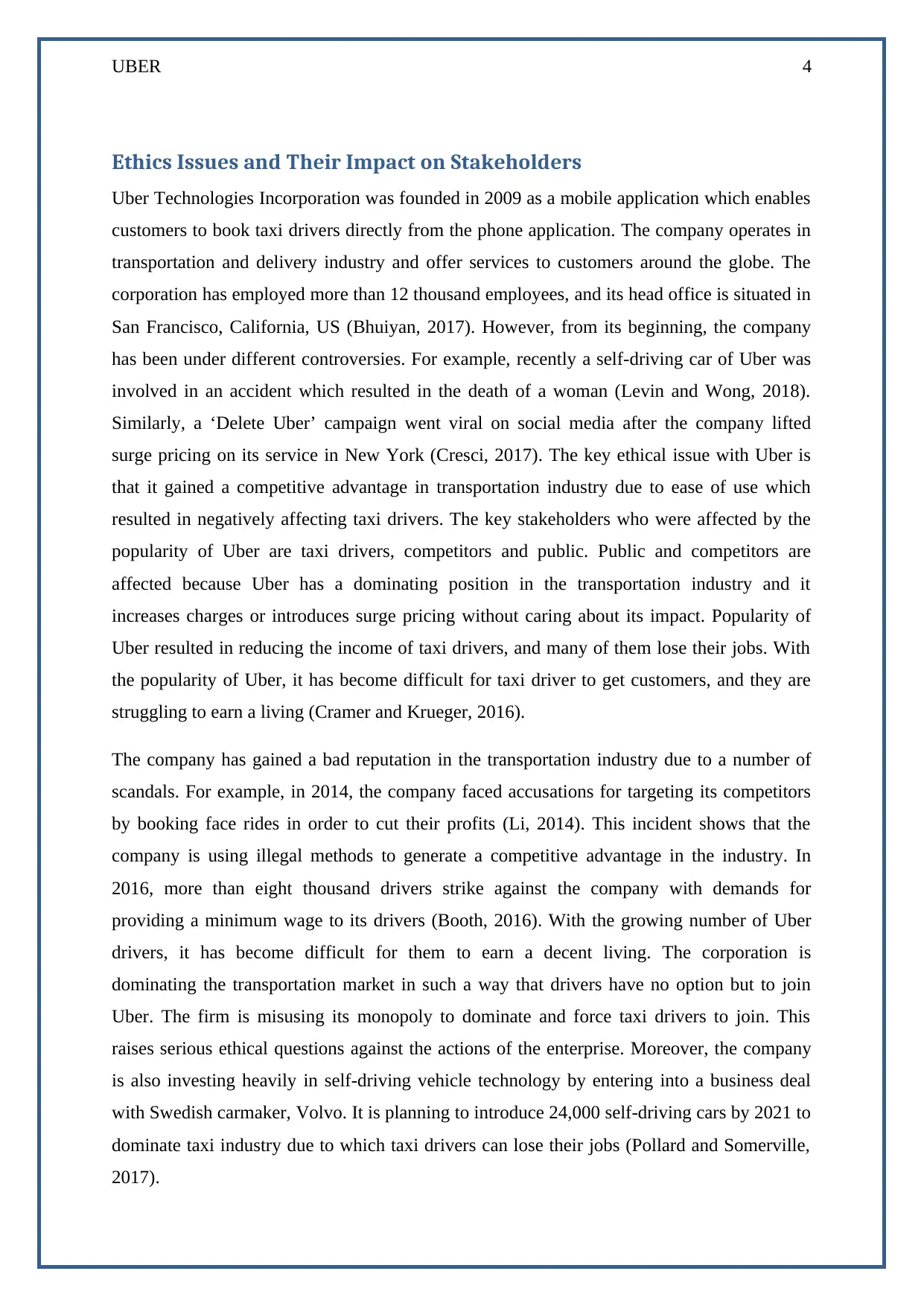
UBER 4
Ethics Issues and Their Impact on Stakeholders
Uber Technologies Incorporation was founded in 2009 as a mobile application which enables
customers to book taxi drivers directly from the phone application. The company operates in
transportation and delivery industry and offer services to customers around the globe. The
corporation has employed more than 12 thousand employees, and its head office is situated in
San Francisco, California, US (Bhuiyan, 2017). However, from its beginning, the company
has been under different controversies. For example, recently a self-driving car of Uber was
involved in an accident which resulted in the death of a woman (Levin and Wong, 2018).
Similarly, a ‘Delete Uber’ campaign went viral on social media after the company lifted
surge pricing on its service in New York (Cresci, 2017). The key ethical issue with Uber is
that it gained a competitive advantage in transportation industry due to ease of use which
resulted in negatively affecting taxi drivers. The key stakeholders who were affected by the
popularity of Uber are taxi drivers, competitors and public. Public and competitors are
affected because Uber has a dominating position in the transportation industry and it
increases charges or introduces surge pricing without caring about its impact. Popularity of
Uber resulted in reducing the income of taxi drivers, and many of them lose their jobs. With
the popularity of Uber, it has become difficult for taxi driver to get customers, and they are
struggling to earn a living (Cramer and Krueger, 2016).
The company has gained a bad reputation in the transportation industry due to a number of
scandals. For example, in 2014, the company faced accusations for targeting its competitors
by booking face rides in order to cut their profits (Li, 2014). This incident shows that the
company is using illegal methods to generate a competitive advantage in the industry. In
2016, more than eight thousand drivers strike against the company with demands for
providing a minimum wage to its drivers (Booth, 2016). With the growing number of Uber
drivers, it has become difficult for them to earn a decent living. The corporation is
dominating the transportation market in such a way that drivers have no option but to join
Uber. The firm is misusing its monopoly to dominate and force taxi drivers to join. This
raises serious ethical questions against the actions of the enterprise. Moreover, the company
is also investing heavily in self-driving vehicle technology by entering into a business deal
with Swedish carmaker, Volvo. It is planning to introduce 24,000 self-driving cars by 2021 to
dominate taxi industry due to which taxi drivers can lose their jobs (Pollard and Somerville,
2017).
Ethics Issues and Their Impact on Stakeholders
Uber Technologies Incorporation was founded in 2009 as a mobile application which enables
customers to book taxi drivers directly from the phone application. The company operates in
transportation and delivery industry and offer services to customers around the globe. The
corporation has employed more than 12 thousand employees, and its head office is situated in
San Francisco, California, US (Bhuiyan, 2017). However, from its beginning, the company
has been under different controversies. For example, recently a self-driving car of Uber was
involved in an accident which resulted in the death of a woman (Levin and Wong, 2018).
Similarly, a ‘Delete Uber’ campaign went viral on social media after the company lifted
surge pricing on its service in New York (Cresci, 2017). The key ethical issue with Uber is
that it gained a competitive advantage in transportation industry due to ease of use which
resulted in negatively affecting taxi drivers. The key stakeholders who were affected by the
popularity of Uber are taxi drivers, competitors and public. Public and competitors are
affected because Uber has a dominating position in the transportation industry and it
increases charges or introduces surge pricing without caring about its impact. Popularity of
Uber resulted in reducing the income of taxi drivers, and many of them lose their jobs. With
the popularity of Uber, it has become difficult for taxi driver to get customers, and they are
struggling to earn a living (Cramer and Krueger, 2016).
The company has gained a bad reputation in the transportation industry due to a number of
scandals. For example, in 2014, the company faced accusations for targeting its competitors
by booking face rides in order to cut their profits (Li, 2014). This incident shows that the
company is using illegal methods to generate a competitive advantage in the industry. In
2016, more than eight thousand drivers strike against the company with demands for
providing a minimum wage to its drivers (Booth, 2016). With the growing number of Uber
drivers, it has become difficult for them to earn a decent living. The corporation is
dominating the transportation market in such a way that drivers have no option but to join
Uber. The firm is misusing its monopoly to dominate and force taxi drivers to join. This
raises serious ethical questions against the actions of the enterprise. Moreover, the company
is also investing heavily in self-driving vehicle technology by entering into a business deal
with Swedish carmaker, Volvo. It is planning to introduce 24,000 self-driving cars by 2021 to
dominate taxi industry due to which taxi drivers can lose their jobs (Pollard and Somerville,
2017).
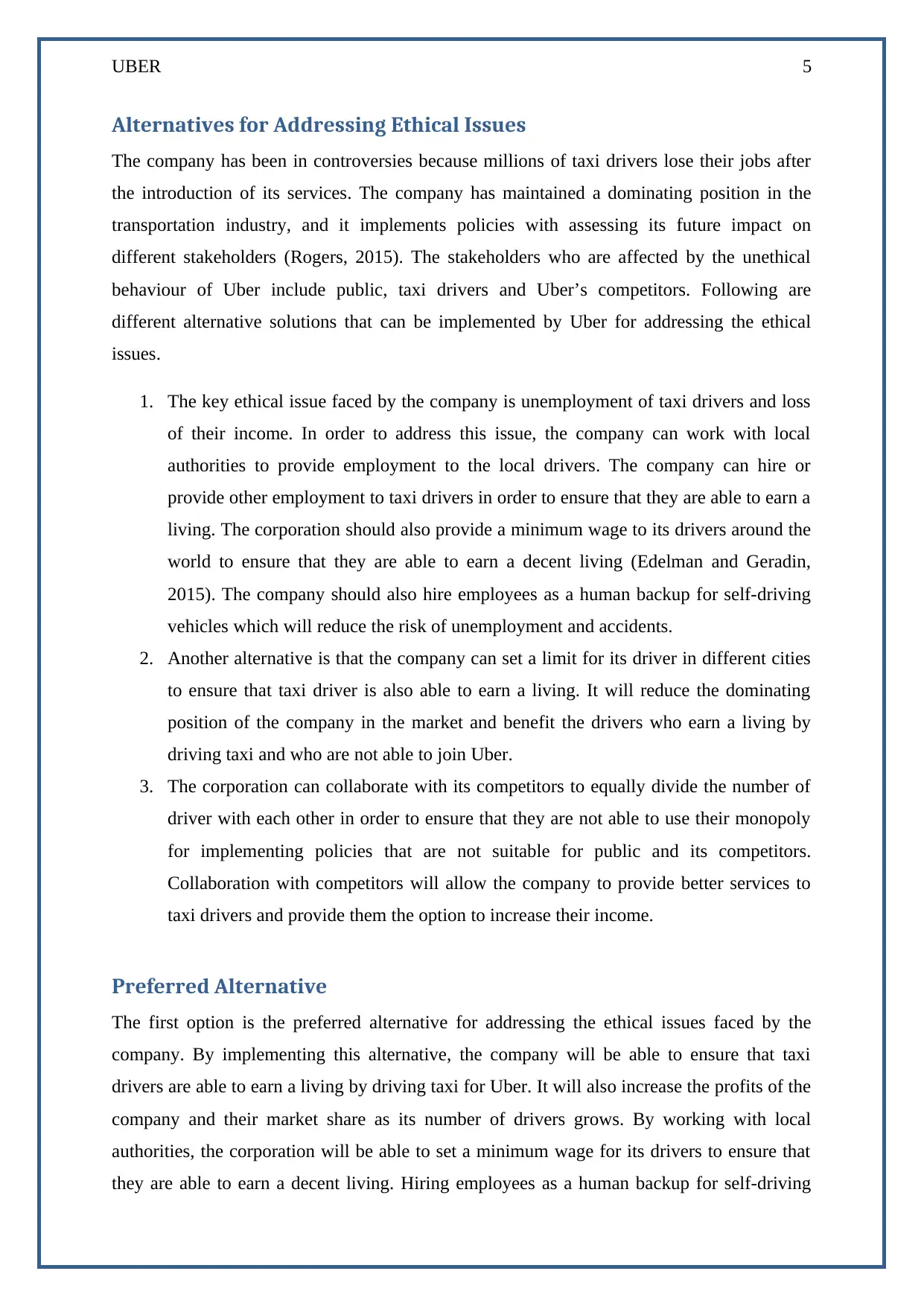
UBER 5
Alternatives for Addressing Ethical Issues
The company has been in controversies because millions of taxi drivers lose their jobs after
the introduction of its services. The company has maintained a dominating position in the
transportation industry, and it implements policies with assessing its future impact on
different stakeholders (Rogers, 2015). The stakeholders who are affected by the unethical
behaviour of Uber include public, taxi drivers and Uber’s competitors. Following are
different alternative solutions that can be implemented by Uber for addressing the ethical
issues.
1. The key ethical issue faced by the company is unemployment of taxi drivers and loss
of their income. In order to address this issue, the company can work with local
authorities to provide employment to the local drivers. The company can hire or
provide other employment to taxi drivers in order to ensure that they are able to earn a
living. The corporation should also provide a minimum wage to its drivers around the
world to ensure that they are able to earn a decent living (Edelman and Geradin,
2015). The company should also hire employees as a human backup for self-driving
vehicles which will reduce the risk of unemployment and accidents.
2. Another alternative is that the company can set a limit for its driver in different cities
to ensure that taxi driver is also able to earn a living. It will reduce the dominating
position of the company in the market and benefit the drivers who earn a living by
driving taxi and who are not able to join Uber.
3. The corporation can collaborate with its competitors to equally divide the number of
driver with each other in order to ensure that they are not able to use their monopoly
for implementing policies that are not suitable for public and its competitors.
Collaboration with competitors will allow the company to provide better services to
taxi drivers and provide them the option to increase their income.
Preferred Alternative
The first option is the preferred alternative for addressing the ethical issues faced by the
company. By implementing this alternative, the company will be able to ensure that taxi
drivers are able to earn a living by driving taxi for Uber. It will also increase the profits of the
company and their market share as its number of drivers grows. By working with local
authorities, the corporation will be able to set a minimum wage for its drivers to ensure that
they are able to earn a decent living. Hiring employees as a human backup for self-driving
Alternatives for Addressing Ethical Issues
The company has been in controversies because millions of taxi drivers lose their jobs after
the introduction of its services. The company has maintained a dominating position in the
transportation industry, and it implements policies with assessing its future impact on
different stakeholders (Rogers, 2015). The stakeholders who are affected by the unethical
behaviour of Uber include public, taxi drivers and Uber’s competitors. Following are
different alternative solutions that can be implemented by Uber for addressing the ethical
issues.
1. The key ethical issue faced by the company is unemployment of taxi drivers and loss
of their income. In order to address this issue, the company can work with local
authorities to provide employment to the local drivers. The company can hire or
provide other employment to taxi drivers in order to ensure that they are able to earn a
living. The corporation should also provide a minimum wage to its drivers around the
world to ensure that they are able to earn a decent living (Edelman and Geradin,
2015). The company should also hire employees as a human backup for self-driving
vehicles which will reduce the risk of unemployment and accidents.
2. Another alternative is that the company can set a limit for its driver in different cities
to ensure that taxi driver is also able to earn a living. It will reduce the dominating
position of the company in the market and benefit the drivers who earn a living by
driving taxi and who are not able to join Uber.
3. The corporation can collaborate with its competitors to equally divide the number of
driver with each other in order to ensure that they are not able to use their monopoly
for implementing policies that are not suitable for public and its competitors.
Collaboration with competitors will allow the company to provide better services to
taxi drivers and provide them the option to increase their income.
Preferred Alternative
The first option is the preferred alternative for addressing the ethical issues faced by the
company. By implementing this alternative, the company will be able to ensure that taxi
drivers are able to earn a living by driving taxi for Uber. It will also increase the profits of the
company and their market share as its number of drivers grows. By working with local
authorities, the corporation will be able to set a minimum wage for its drivers to ensure that
they are able to earn a decent living. Hiring employees as a human backup for self-driving
⊘ This is a preview!⊘
Do you want full access?
Subscribe today to unlock all pages.

Trusted by 1+ million students worldwide

UBER 6
cars is also a good option for reducing accidents. It will also reduce the unemployment rate in
different countries. Therefore, this is the preferred alternative for addressing the ethical issue
faced by Uber.
cars is also a good option for reducing accidents. It will also reduce the unemployment rate in
different countries. Therefore, this is the preferred alternative for addressing the ethical issue
faced by Uber.
Paraphrase This Document
Need a fresh take? Get an instant paraphrase of this document with our AI Paraphraser
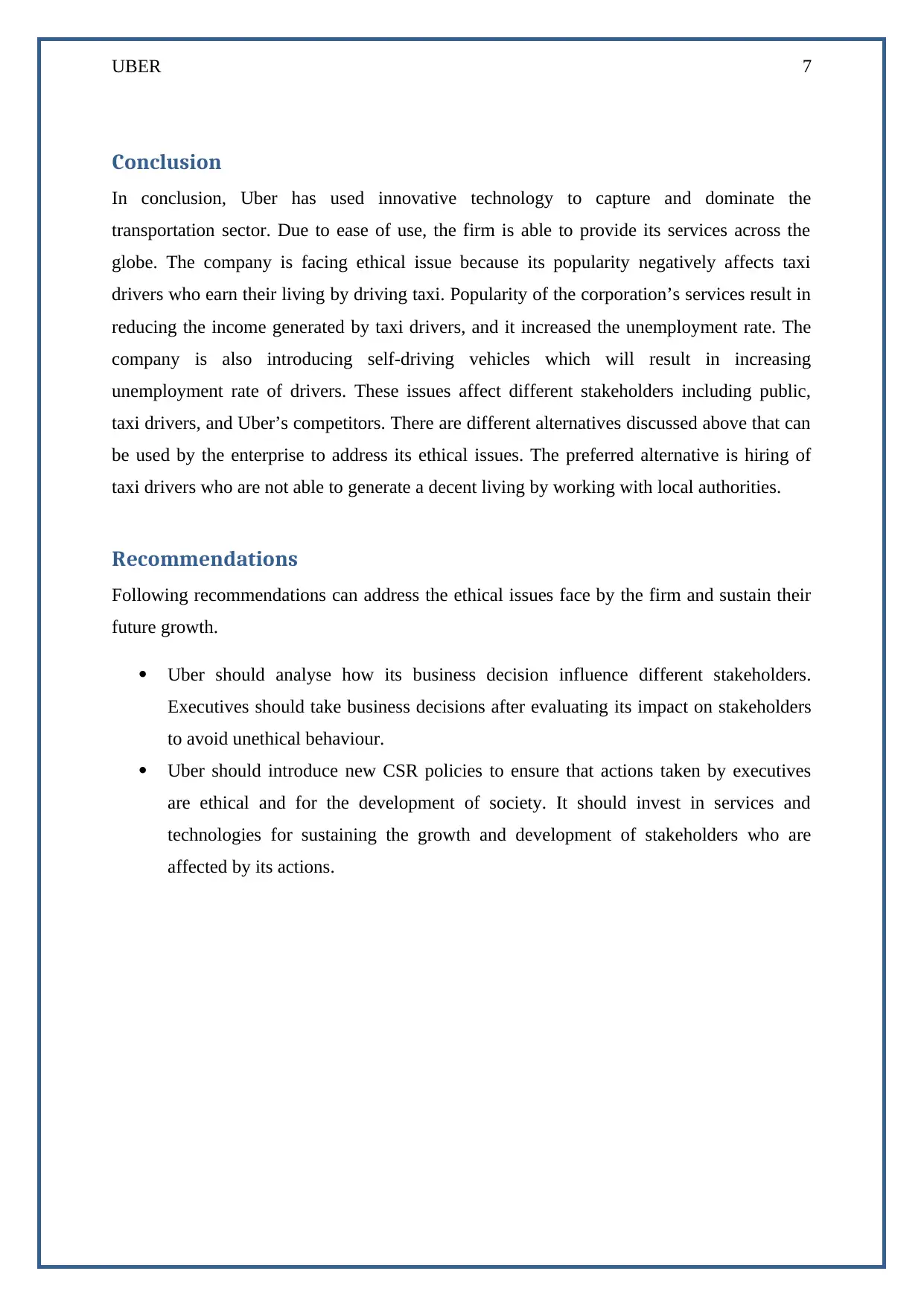
UBER 7
Conclusion
In conclusion, Uber has used innovative technology to capture and dominate the
transportation sector. Due to ease of use, the firm is able to provide its services across the
globe. The company is facing ethical issue because its popularity negatively affects taxi
drivers who earn their living by driving taxi. Popularity of the corporation’s services result in
reducing the income generated by taxi drivers, and it increased the unemployment rate. The
company is also introducing self-driving vehicles which will result in increasing
unemployment rate of drivers. These issues affect different stakeholders including public,
taxi drivers, and Uber’s competitors. There are different alternatives discussed above that can
be used by the enterprise to address its ethical issues. The preferred alternative is hiring of
taxi drivers who are not able to generate a decent living by working with local authorities.
Recommendations
Following recommendations can address the ethical issues face by the firm and sustain their
future growth.
Uber should analyse how its business decision influence different stakeholders.
Executives should take business decisions after evaluating its impact on stakeholders
to avoid unethical behaviour.
Uber should introduce new CSR policies to ensure that actions taken by executives
are ethical and for the development of society. It should invest in services and
technologies for sustaining the growth and development of stakeholders who are
affected by its actions.
Conclusion
In conclusion, Uber has used innovative technology to capture and dominate the
transportation sector. Due to ease of use, the firm is able to provide its services across the
globe. The company is facing ethical issue because its popularity negatively affects taxi
drivers who earn their living by driving taxi. Popularity of the corporation’s services result in
reducing the income generated by taxi drivers, and it increased the unemployment rate. The
company is also introducing self-driving vehicles which will result in increasing
unemployment rate of drivers. These issues affect different stakeholders including public,
taxi drivers, and Uber’s competitors. There are different alternatives discussed above that can
be used by the enterprise to address its ethical issues. The preferred alternative is hiring of
taxi drivers who are not able to generate a decent living by working with local authorities.
Recommendations
Following recommendations can address the ethical issues face by the firm and sustain their
future growth.
Uber should analyse how its business decision influence different stakeholders.
Executives should take business decisions after evaluating its impact on stakeholders
to avoid unethical behaviour.
Uber should introduce new CSR policies to ensure that actions taken by executives
are ethical and for the development of society. It should invest in services and
technologies for sustaining the growth and development of stakeholders who are
affected by its actions.
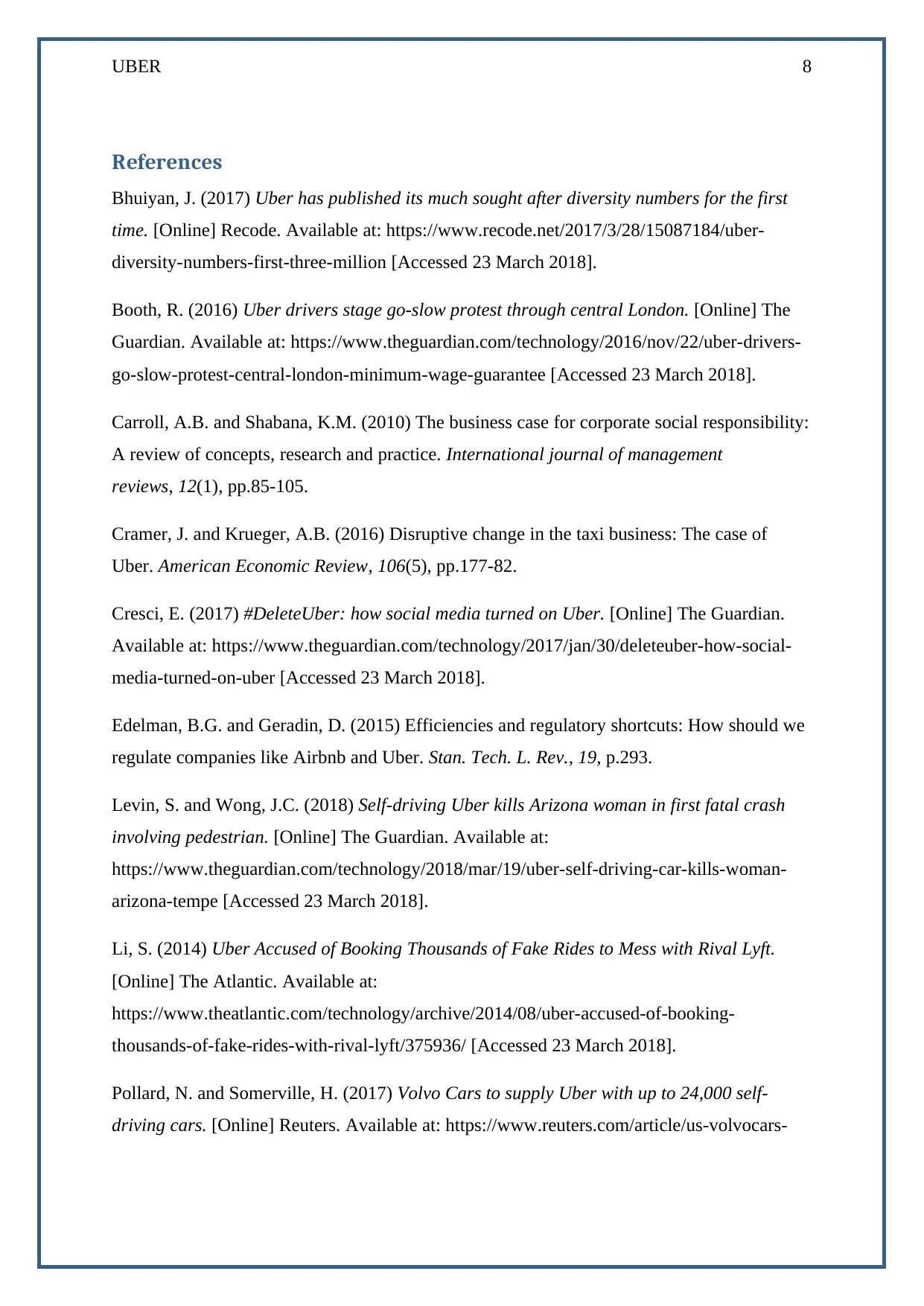
UBER 8
References
Bhuiyan, J. (2017) Uber has published its much sought after diversity numbers for the first
time. [Online] Recode. Available at: https://www.recode.net/2017/3/28/15087184/uber-
diversity-numbers-first-three-million [Accessed 23 March 2018].
Booth, R. (2016) Uber drivers stage go-slow protest through central London. [Online] The
Guardian. Available at: https://www.theguardian.com/technology/2016/nov/22/uber-drivers-
go-slow-protest-central-london-minimum-wage-guarantee [Accessed 23 March 2018].
Carroll, A.B. and Shabana, K.M. (2010) The business case for corporate social responsibility:
A review of concepts, research and practice. International journal of management
reviews, 12(1), pp.85-105.
Cramer, J. and Krueger, A.B. (2016) Disruptive change in the taxi business: The case of
Uber. American Economic Review, 106(5), pp.177-82.
Cresci, E. (2017) #DeleteUber: how social media turned on Uber. [Online] The Guardian.
Available at: https://www.theguardian.com/technology/2017/jan/30/deleteuber-how-social-
media-turned-on-uber [Accessed 23 March 2018].
Edelman, B.G. and Geradin, D. (2015) Efficiencies and regulatory shortcuts: How should we
regulate companies like Airbnb and Uber. Stan. Tech. L. Rev., 19, p.293.
Levin, S. and Wong, J.C. (2018) Self-driving Uber kills Arizona woman in first fatal crash
involving pedestrian. [Online] The Guardian. Available at:
https://www.theguardian.com/technology/2018/mar/19/uber-self-driving-car-kills-woman-
arizona-tempe [Accessed 23 March 2018].
Li, S. (2014) Uber Accused of Booking Thousands of Fake Rides to Mess with Rival Lyft.
[Online] The Atlantic. Available at:
https://www.theatlantic.com/technology/archive/2014/08/uber-accused-of-booking-
thousands-of-fake-rides-with-rival-lyft/375936/ [Accessed 23 March 2018].
Pollard, N. and Somerville, H. (2017) Volvo Cars to supply Uber with up to 24,000 self-
driving cars. [Online] Reuters. Available at: https://www.reuters.com/article/us-volvocars-
References
Bhuiyan, J. (2017) Uber has published its much sought after diversity numbers for the first
time. [Online] Recode. Available at: https://www.recode.net/2017/3/28/15087184/uber-
diversity-numbers-first-three-million [Accessed 23 March 2018].
Booth, R. (2016) Uber drivers stage go-slow protest through central London. [Online] The
Guardian. Available at: https://www.theguardian.com/technology/2016/nov/22/uber-drivers-
go-slow-protest-central-london-minimum-wage-guarantee [Accessed 23 March 2018].
Carroll, A.B. and Shabana, K.M. (2010) The business case for corporate social responsibility:
A review of concepts, research and practice. International journal of management
reviews, 12(1), pp.85-105.
Cramer, J. and Krueger, A.B. (2016) Disruptive change in the taxi business: The case of
Uber. American Economic Review, 106(5), pp.177-82.
Cresci, E. (2017) #DeleteUber: how social media turned on Uber. [Online] The Guardian.
Available at: https://www.theguardian.com/technology/2017/jan/30/deleteuber-how-social-
media-turned-on-uber [Accessed 23 March 2018].
Edelman, B.G. and Geradin, D. (2015) Efficiencies and regulatory shortcuts: How should we
regulate companies like Airbnb and Uber. Stan. Tech. L. Rev., 19, p.293.
Levin, S. and Wong, J.C. (2018) Self-driving Uber kills Arizona woman in first fatal crash
involving pedestrian. [Online] The Guardian. Available at:
https://www.theguardian.com/technology/2018/mar/19/uber-self-driving-car-kills-woman-
arizona-tempe [Accessed 23 March 2018].
Li, S. (2014) Uber Accused of Booking Thousands of Fake Rides to Mess with Rival Lyft.
[Online] The Atlantic. Available at:
https://www.theatlantic.com/technology/archive/2014/08/uber-accused-of-booking-
thousands-of-fake-rides-with-rival-lyft/375936/ [Accessed 23 March 2018].
Pollard, N. and Somerville, H. (2017) Volvo Cars to supply Uber with up to 24,000 self-
driving cars. [Online] Reuters. Available at: https://www.reuters.com/article/us-volvocars-
⊘ This is a preview!⊘
Do you want full access?
Subscribe today to unlock all pages.

Trusted by 1+ million students worldwide

UBER 9
uber/volvo-cars-to-supply-uber-with-up-to-24000-self-driving-cars-idUSKBN1DK1NH
[Accessed 23 March 2018].
Rogers, B. (2015) The social costs of Uber. U. Chi. L. Rev. Dialogue, 82, p.85.
uber/volvo-cars-to-supply-uber-with-up-to-24000-self-driving-cars-idUSKBN1DK1NH
[Accessed 23 March 2018].
Rogers, B. (2015) The social costs of Uber. U. Chi. L. Rev. Dialogue, 82, p.85.
1 out of 10
Related Documents
Your All-in-One AI-Powered Toolkit for Academic Success.
+13062052269
info@desklib.com
Available 24*7 on WhatsApp / Email
![[object Object]](/_next/static/media/star-bottom.7253800d.svg)
Unlock your academic potential
Copyright © 2020–2025 A2Z Services. All Rights Reserved. Developed and managed by ZUCOL.




